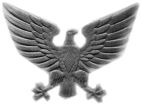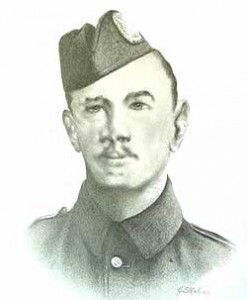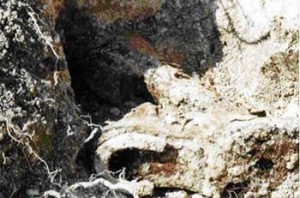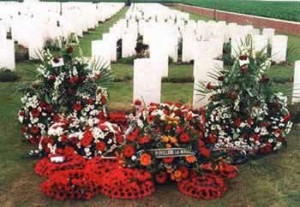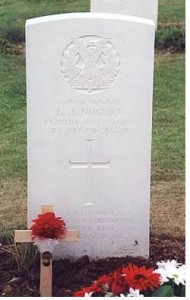Tribute To George Nugent
George Nugent 22/1306 22nd Battalion 3rd Tyneside Scottish Northumberland Fusiliers 7th December 1887-1st July 1916
I had never classed myself as an expert,( there are far too many of those out there) simply an enthusiast, with a passion for the Somme. I, like many others, find it a very emotional experience just walking the Battlefield, retracing the steps of men who fought and died on that ground. Like most people that visit the area, it is rewarding to bring home some kind of trophy” however small and insignificant – every piece can tell a story. I had a very good teacher, Paul Reed, helped me to distinguish irregularities that occurred on the ground. I find Paul a mine of information, and a very interesting storyteller. On one of my many visits to the Somme I, along with a colleague, discovered an armourer’s Lewis Gunner’s kit, complete, in its leather satchel. We did have at first some difficulty in identifying some parts, but after a time, it was all identified correctly. “Knowing what to look for” as Paul put it, is half the battle. I have always been lucky with my finds, and I never thought that I would be able to “top” finding the Lewis kit, but oh how wrong I was.
In October 1998,walking the Lochnagar crater with a colleague, on the side opposite the cross, I noticed the shrubbery had freshly been removed, not expecting to find anything, because of the amount of tourists that visit the area, my eyes hopefully scanned the area. Brown stains on the earth do not usually attract my attention, because of the vast amount of shrapnel littering the whole area, but on this occasion I noticed some brass .303 cases lying on the top of the soil. I bent down, expecting to find another batch of ammunition, but noticed a boot heel plate lying beside them.
Scooping the earth carefully away revealed a boot, complete and in remarkably good condition, only when I looked inside did I discover the bones were still in them. A little further down, and the other boot was discovered, along with various buckles from ’14 pattern leather webbing. It didn’t take long to realize that it was a complete body that had been found. Contrary to what people think, it was a very moving experience. It made me feel that the earth had simply just given him up. It was his time. Everything was left in place, and the ground recovered. After contacting the proper authorities we headed for home. The French police investigated the site, and when it was established it was a WW1 body, the Commonwealth War Graves commission were called in to excavate the remains.
After a few weeks the CWGC in Beaurains France sent me a copy of the report on the excavation.
The exhumation was carried out on Tuesday 3rd November 1998,on the far side (from the entrance) of the Lochnagar Crater on the flat ground beyond the rim, and the following items were recovered:
One human body consisting of broken skull, jawbone, teeth, vertebrae, limbs, ribs, pelvis, hands and feet. One pair of Army Boots, 100 bullets. One rifle, with bayonet wire cutters attached, One rifle butt plate, Gas mask eye pieces, Two water bottles (one Canadian, One British) One pair of scissors, safety pin, food tin, one oil bottle, two pocket knives, one pipe mouthpiece, eight buckles/belt ends, 20 small buttons, one silver, hallmarked pen holder with inscription, one cap badge, and shoulder title TYNESIDE 3 SCOTTISH one folding cut throat razor inscribed G Nugent 1306.
There were many speculations as to what was found on the body, but this was the full list. The body was then interred into Beaurains mortuary, awaiting identification.
After the body was found in November 98 the MOD contacted John Sheen in the first week of Dec 98 to see if he would be able to help them with identification. At that stage the Ministry of Defence and the Commonwealth War Graves Commission did have some information on Pte. Nugent, – his entry in the CWGC database and his entry in “Soldiers Died in the Great War,” which gave his place of birth, residence and enlistment as Newcastle and his place of commemoration as the Thiepval Memorial to the Missing, Somme, France. At this stage in their inquiries, the Ministry of Defence had not revealed that they had found a razor with a service number on it. However, the Great War “grapevine” is very effective and many people knew the possible identity of the soldier before it was officially announced. John Sheen certainly did, when he went for his meeting with the staff of PS4, the Army department which looks after casualty and compassionate matters.
To begin with, there was some gentle probing, with the army representatives being very reluctant to reveal a name in which they were interested, and John having to repeat that without a name he was unable to even begin to look into the possibility of his having any useful information. Eventually, John revealed that he already knew the name they had in mind and had brought some information to the meeting with him – information which he and his co-author Graham Stewart had already researched for their book, “Tyneside Scottish:”
Private Nugent’s date of enlistment, was discovered from the “Newcastle Evening Chronicle;” His home address from the same source; Details of Pte. Nugent’s Section and Company from Red Cross missing lists; A report that Pte. Nugent was reported missing, taken from “St. George’s Gazette;” From the same magazine, a report dated February, 1917, stating that Pte. Nugent was presumed dead.
It was the razor bearing Pte. Nugent’s name and number that finally convinced the authorities who it was they were dealing with . The staff at PS4 had little or no experience of researching WW1 soldiers – to be fair to them, this was not really their job – and John showed them the nominal rolls from his first book “Tyneside Irish” and gave them a briefing on what, where and how to go about it. He also showed them the rolls that he and his co-author, Graham Stewart, were preparing for “Tyneside Scottish.” Having established the authority with which he could speak on the Tyneside battalions of so long ago, John called into play his 25 years’ experience as a serving soldier in addition when he said that then, as now, soldiers were expected to shave every day, and to shave themselves. Thus a soldier’s razor is one piece of kit which he carries with him into action. Furthermore, no soldier would shave with another man’s razor if he could possibly avoid it, for obvious health reasons. Therefore, the only reasonable assumption was that the soldier found at the Lochnagar Crater, carrying Pte. Nugent’s razor, was indeed Pte. Nugent. The meeting lasted for about three hours.
Many articles have been written on the subject, especially in the north of England, I was surprised at the amount of interest it had generated from the media, Nobody will ever know for certain how he died, and what horrors he saw, but one thing is for certain, George Nugent was given his just burial, with full military honours on 1st July 2000 at Ovillers cemetery in France, finally laid to rest. On 2nd June 2000 ,the surviving family of George Nugent were found by the MOD There was a burial with full military honours on 1st July 2000, and I was proud to be part of it, As a footnote I would especially like to thank Geoff Stevens, who, as a keen artist, “penciled” a drawing of George Nugent from the only known photograph which came from a local newspaper.
George James Nugent was born in Newcastle on 27th December 1887. His parents were William Nugent, a slipper maker born and bred in Newcastle, and Emma Nugent ( nee) Pleasant, whose family originated from Norwich, but who had moved to Newcastle.
George was the fourth of five children. The other children being Emma (1880), John William (1883) Robert (1885) and Elizabeth (1891) At the time of George’s birth the Nugent family were living at Stepney Lane in the All Saints district of Newcastle.
George and Mary had one child, Mary, who was born on 15th June 1915. A year later George Nugent was killed on the first day of the Battle of the Somme, 1st July 1916, whilst serving with 22nd Battalion (3rd Tyneside Scottish) Northumberland Fusiliers. He was one of 537 casualties the 3rd Battalion Tyneside Scottish suffered that day. At some point following George’s death Norah and Mary moved back to Leeds as records show that on 17th July 1918 Norah married Peter Matthews at St Patrick’s Church in Quarryhill Leeds.Mary Nugent (George and Norah’s only child) moved to London in early adulthood (date unknown). She married twice, first James William Clare Childs in Westminster in 1943, aged 28, and then in 1960, aged 43 to Edward Alcock( again in Westminster) Edward Alcock had a daughter from a previous marriage -Edith June Jones – who became Mary’s step-daughter, and registered her death, Mary had no children by either James Childs, or by Edward Alcock. Mary died in London on 24th July 1987. She never knew her father, or what became of him.
“Soldier Sleep Sound”
